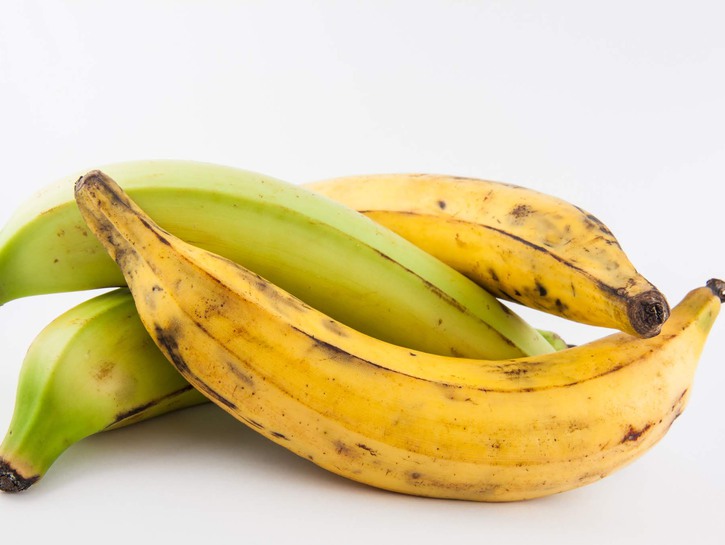Plantains (sometimes referred to as a cooking banana) and bananas are both used in a variety of sweet and savory food preparations. Although their similar appearance makes them a little difficult to tell apart, they are like night and day. For one, plantains are larger and are often greener with thicker skin, while bananas typically have a yellow exterior and are soft and sweet when at their ripest. However, these two differences are just the tip of the iceberg when it comes to telling the two produce apart. Whether you enjoy both, never tasted either or are just interested in just what makes them so different, here are some facts and differences between plantains and bananas.
Similarities Between Plantains And Bananas

Both types of fruit are generally starchy and can be peeled and eaten ripe or unripe to obtain a variety of vitamins and minerals. Plantains and bananas are also similar in shape, which helps makes them easy to pick, peel and prepare for a variety of meals. Although they taste quite differently, they both provide a large dose of complex carbohydrates, which is ideal for obtaining an energy boost when you need it most.
- Coinciding nutritional values
- Both are fruit
- Similar shapes
- Similar colors
- Starchy consistency
Differences Between Plantains And Bananas

Like bananas, plantains are generally starchy and can be peeled and eaten ripe or unripe. However, plantains have less sugar and continue to stay green when they are more ripe, unlike a banana that tends to turn yellow when it reaches its peak growth. Due to plantains’ starchy nature, they are ideal for a variety of savory meals. Since they taste similar to potatoes when cooked, plantains are a healthy means to obtains a variety of vitamins and minerals to your diet. Like the plantain, bananas also contain a considerable amount of starch, except they taste sweeter.
Because of the vastly different tastes of plantains and bananas, their culinary preparations are vastly different. Unlike bananas that can easily be peeled at the peak of ripeness, plantains need to be sliced or peeled with a knife to get to the meat of the fruit. Additionally, plantations range in color from green to dark brown and can be eaten at any stage, unlike a banana, which is ideally eaten while yellow. Additional differences are:
- Bananas are sweet, plantains are not
- Ripe plantains are green, ripe bananas are yellow
- Plantains are best cooked, bananas can be eaten raw
What Is A Plantain?

Plantains are a fruit that is believed to have originated in Southeast Asia. Plantains grow on the plantain tree in clusters that can easily be picked and cultivated in a variety of meals. Plantains are also similar to other starchy fares, such as yams, sweet potatoes, and taro. Because yams are typically too firm to eat raw, they are usually cooked before serving. However, they can be eaten both ways. Since plantains are similar to potatoes when cooked, plantains are a healthy means to obtains a variety of vitamins and minerals to your diet.
What Is A Banana?

Bananas also referred to as dessert bananas are a fruit that is full nutritional value are noted for their soft peelable exteriors that encompass a creamy, sweet interior that can be mashed to create many lightly sweet concoctions, such as banana bread muffins and other tasty treats. Like plantains, bananas contain a healthy amount of vitamins and minerals which helps to boost your energy and keep you going when you need a boost.
Plantain And Banana Tostones

Thinly sliced fried plantains and bananas are often referred to as Tostones and can be lightly sweet, salty, or caramelized, depending on your preference. They make a great alternative to potato chips, which can be laden with saturated fat. They may also be topped with hors-d’oeuvres or added to soups and salads. Here is a quick and simple recipe:
Ingredients
- 2 green plantains
- 3/4 cups of oil
- A bowl of iced water
- Kosher coarse salt
Instructions
- Peel and cut the plantains and bananas into diagonal 1/2 inch slices.
- In a large pot, pour 12 tablespoons of oil on medium-low heat.
- Place the plantains and bananas into the oil and allow to sizzle, cooking until brown on one side. Then turn them over and cook the other side, pressing down. You want to achieve a nice brown on both sides.
- Remove the plantains and dunk them in the bowl of iced water for one minute.
- Take the plantains out of the water and dry them off with paper towel. You want to remove as much water as possible before we put them back in the oil.
- Place the plantains back in the pot with the oil and fry on each side for one minute each.
- Once they are complete, place them on a dish with paper towel to absorb access oil. Salt to taste, and enjoy!
Plantains and bananas are great options to try when you want a healthy snack or if you just love them. Now that you know of their differences and similarities, go out and purchase some of your own and try them in a variety of ways and enjoy!
